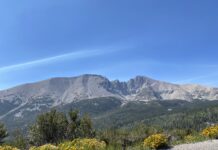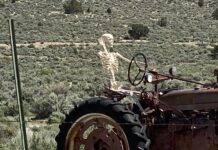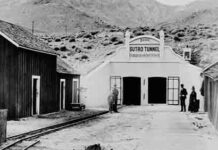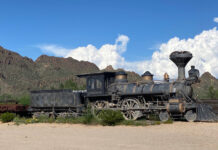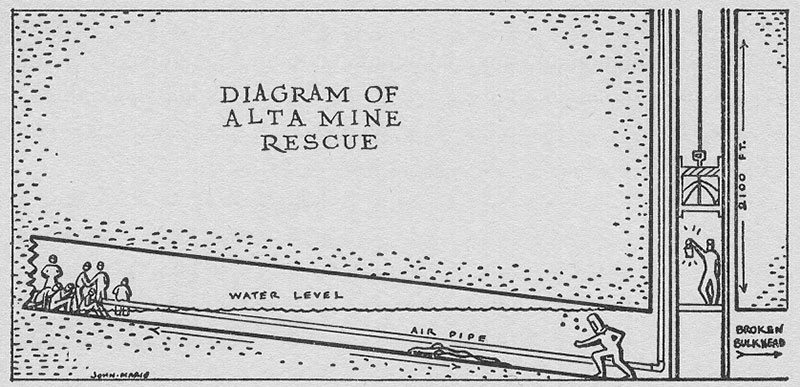
by Harry Gorham
[from “My Memories of the Comstock:
An Eye-Witness Account of the Richest Place on Earth]
To return To the subject of ventilation — those men in Gould and Curry could not escape to a shaft a thousand feet deep or a tunnel 1500 feet long because the deadly gas creeps in too silently, too insidiously, too stealthily. The way to stop that is — not to have any fires.
Lack of cooperation between the mines, suspicious of each other and each other’s motives — that and the effort at secrecy — caused most of the trouble. Take the Gould and Curry fire for example. Johnny Kennedy knew every foot of the Curry ground. He knew that if he could get through a bulkhead, it would be clear sailing. He and his men worked like mad, cleared the bulkhead, and, racing toward what they thought was safety, met death when they found another bulkhead on the north line.
Now what is a bulkhead and why is it used? It is simply a heavily timbered or a cemented stoppage in a drift or other opening, and the strength it is made to bear depends on the purpose for which it is used. It can be made to stop up a drift so that only great labor and time can reopen it, or it can be built so that it will resist a great strain like water pressure. Where water is encountered and the facilities to handle it are such as to require it to be shut off, bulkheads are built.
That was a situation in the Alta mine when E.D. Boyle was superintendent. It was then about the year 1882 — Think of it — 56 years ago.
There came a great disaster — disaster in the loss of time and values, but greater disaster in the loss of life to two Intrepid but rash men who should not have died. I will try to tell you of it, of them, and of a man I have always held in memory as one of the real brave men I have known. I don’t mean brave in the heat of battle, nor brave in the sense of appealing to admiration — but coldly brave — a man who walked into death, the face of death, not because he was ordered, not because it was his duty, but to give aid to men whom those on the surface, knowing the facts, believed already dead.
Now imagine the situation. Let us visualize the Alta shaft. It was about two thousand one hundred feet deep — I do not recall the exact figures — and a drift was run east from this shaft about one thousand feet. There, quite a flow of water was encountered. It was deemed best to stop the drift and bulkhead it against the body of water. This was at best a temporary expedient, for after all, the water must be disposed of. As I have explained, a bulkhead is usually made of timber, laid lengthwise, filling the drift, anchored on the sides, and tamped and caulked to prevent leakage.
Prospecting was continued then in, I think, a drift to the south (though it may have been west — my memory is a little faulty about that) but the direction is quite unimportant. This drift was continued about 1500 feet. As there was no natural circulation of air, fresh air was pumped in through a good-sized air pipe, probably 14 or 16 inches in diameter. This was driven from some point where good air existed — some adjacent point where there was a good air current. And through a small pressure pipe the compressed air for running the drills was conducted from the surface where the compressors were situated.
A track was laid, the drift timbered to prevent caving and the air and compressed air pipes installed. To permit drainage in case of water and to make the cars run easily the drift was run slightly uphill so that at the end of the drift (the face of the drift), fifteen hundred feet from the twenty-one hundred foot station, it was say, fifteen feet higher than at the station.
There were six men working in the face when the bulkhead in the east drift commenced to leak. As it gradually increased its flow, the foreman, Dick Bennett, who had just examined the bulkhead and saw that it was beginning to show great pressure, thought it best to go into the west drift and tell the men to come out. There was threat in this situation. He had no sooner reached the face of the drift then the bulkhead gave way, there was a great flow of water which almost immediately filled the station to the top of the west drift, and there was no escape for the six man or for Bennett, who went to their assistance. Bennett was a fine man.
In the excitement that prevailed, for the news traveled like lightning, all kinds of the rumors obtained. “Ned” Boyle, as the Superintendent was called, was cool, competent, quick. He ordered the blowers to be kept running and every effort bent toward maintaining the pumping equipment.
Slowly the water was pumped down. Then came a break in the pump rod! But working with feverish haste, the repair men got it running again. Slowly — again they gained on the water, until first the top of the drift was shown, then down to say 6 feet on the station.
It will be apparent that, due to the rise in the drift, the water, though at the top of the station, did not go within, say about 200 feet of the imprisoned men.
And now the only tragedy occurred — sad, unnecessary, but due to the impetuous courage of two young men.
You see, hours had given place to days. I think four days had elapsed as men and machinery struggled against that flow of water. As an adjunct to the pumps they used bailing tanks, huge tanks fastened to the bottoms of the cages, which filled and emptied automatically.
Boyle, they superintendent, and Hoskins, the foreman, worked without rest, watching, calculating the chances, not to attempt the rescue too soon, and surely not too late. Tense fear, permeating every home, put every nerve at full stretch.
FInally, on the early morning of, I think, the fourth day, it was believed an attempt might be made to enter the drift. But after further consideration Boyle determined to wait a little longer to make sure.
But two young miners, Dick Bennett and Dennis Callahan (the former a nephew of the shift boss, Bennett, who had gone in to warn the men) became impatient of restraint. They took a canvas boat secured the day before from Fred Ritter, who kept a gun store in the town, and against the orders and wishes of Boyle, went out into the drift, and away beyond into that good Haven — of cold water and fresh earth and green grass and rest from labor — the dream of all good miners, and the bourne of no return.
The emanations from the hot steamy waters confined in that comparatively small opening crept into the lungs and lifestream of these brave boys and they died in the drift only a short distance from its mouth.
In Virginia, there was a plumber and pipefitter named Andrew Peasley. He was a brother of the celebrated Tom Peasley who met death in the Ormsby House in Carson, shot in the back as he sat at the round stove in the middle of the barroom. But after the shot he rose from the floor, walked to the door, and shot the murderer as he fled toward the capitol, lay down and telling them to pull off his boots, died. A great boy, was Tom Peasley.
And Andrew Peasley constructed a helmet, with the chamber to hold ice and with openings to permit the cold air from the ice to enter so that the wearer had cool, clean air to breathe.
John Van Duzen, “Yank” Van Duzen as everyone knew him, volunteered to put on this helmet, fill it with ice and explore the drift. He started, and not far in, passed the dead Bennett and Callahan — and then on and on into the face of the drift where he found those seven men huddled at the air pipe.
He told me afterward that never in his life had he had such a thrill as when he saw them, weak, thirsty, exhausted, but alive. They seized his helmet and almost emptied it of ice — they were famished for it. But in so doing they almost caused the death of Van Duzen, who went back to report, and found great difficulty in making it due to the depletion of the ice in his helmet.
Some of the men who listened, some of the spectators, thought that Van Duzen had been made balmy by the gases and that his story was a pipe dream. But that did not alter the cool assurance of “Yank”. And in a few hours more — not long — they brought out the men; they were rescued and all lived. Not over two or three hours later the pump rod broke, the mine flooded, and though I may be mistaken I believe that was the last that has been seen of the twenty-one hundred foot level of the Alta mine.
Away down in the bowels of that mine is a drift filled with water, possibly they air pipes still leading in there, where seven men huddled in a corner while above them dozens of their fellow workmen strove with the forces of Nature to bring rescue to them — long, long years ago.
I knew only one of the men in the drift — Milligan, who lived near the Imperial Mine. I went to his house to congratulate him on his miraculous escape. He was in bed, wan, weary, tearful, but smiling withal. I talked a moment or two with him on his experience, and among other things he said, “Now next to the men in the drift I think the greatest credit is due to ‘Yank’ Van Dusen.” Is not that a comment on the logic of the average of us poor humans.
The men in the drift were caught there, much against their will, but “Yank” cool, calm, determined, walked over two dead men who perished in a similar effort, gave up over half of the life-giving ice to the famished prisoners — was he brave? For remember, he was not ordered in there; he volunteered. And it was a grand action. So you can see that next to the men in the drift “the most credit was due to ‘Yank'”.
And I shall never forget the talk I had with Yank when he told me, in his slow drawl that gave him his nickname, of that little walk of 1500 feet through stinking water, past the dead boys, and up seeing those men who had been deemed dead — alive. History is filled with the details of brave men and women — and I think possibly that with few exceptions, given the chance and circumstances — most humans are brave.
I know of quite a number who have risked life for others. My uncle, John P. Jones, while he was superintendent of the Crown point, when the yellow jacket fire took place, went down in the Crown Point shaft through gas and smoke and brought to the surface Dick Nagle, who was marooned there and practically helpless. And Jones, himself, was all but dead at the end of the rescue.
There was Pignalia n the Curry fire, who went down the shaft and brought out the men at the station. Brave, that is the word; it was pure courage.
But as I think over the few whom I have known, or of whom I have read, I think three names stand out in my mind and memory. I never recall them without saying in my heart, “God rest them.”
There was a Eliza Donner, the wife of Captain Donner, both of whom were members of that ill-fated party caught in the snow on the Truckee Summit. Captain Donner, ill unto death, lay in a hole twenty feet under the surface in the snow. The rescuers struggling in were able to take only a few of the party. Mrs. Donner dressed her little girl Eliza, carried her out and putting her in the arms of one of the search party, crawled back into that hole again to die with her husband. The little girl grew to womanhood, married a man named Houghton, lived for quite a few years in Los Angeles, wrote the story of the Donner party, and died only a short time ago — aged over eighty.
William T. Manley was a member of the Bennett party in Death Valley in 1849. They had advanced in their trek westward across the desert as far as what is known at the present time as Bennett Wells. They could go no farther. Hungry, thirsty, sick, some were dying and some dead. The cattle starved, and the heat was unbearable.
Manley knew that death awaited them unless they could secure help. They talked it over, and finally Manley and a young man named Rogers volunteered to make the effort. They walked from Bennett Wells in Death Valley to San Fernando Mission. They secured supplies, they bought a little white mule, and they walked back into that hell hole. How far? I don’t know. I have driven it many times in a motor car over fine roads with stations and supplies every few miles. I know that it took them twenty-seven days of continuous strenuous effort, the first half enjoyed with little or no food.
There were no roads, no paths even — just two brave, courageous, determined, strong young men, and they brought the remnants of the party out into glorious California.
When Mrs. Bennett saw these grim rescuers clambering back over the rocks, she threw her arms in and screamed, “The boys have come back!” If you want to read an epic, one that will stir the most sluggish imagination, arouse the slowest to enthusiasm, read Manley’s Death Valley in 1849.
Of “Yank” Va Duzen I have already spoken. Hundreds of others — thousands of others have had the fortitude that makes men to face death, to find the truth that “the fittest place where man can die is where he dies for man! But when I think of those for and what they did, I forget disappointments, I forget “man’s inhumanity to man” — for the Spirit of God was in them.



